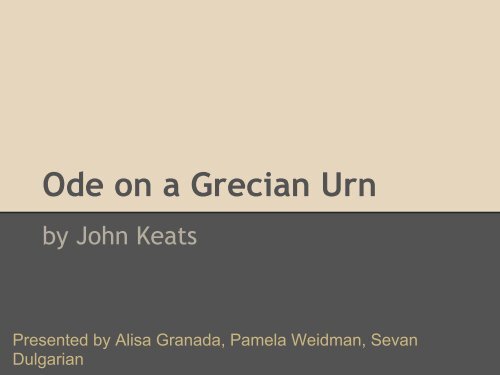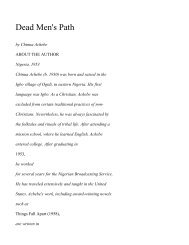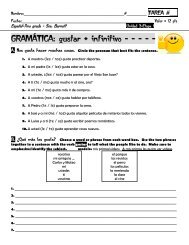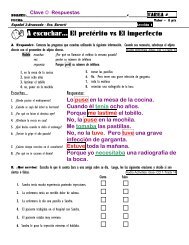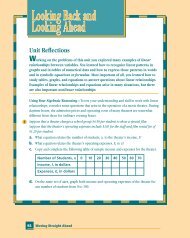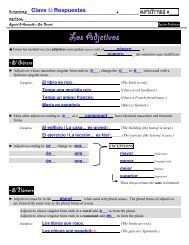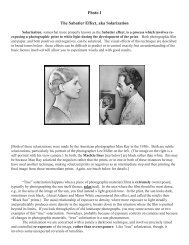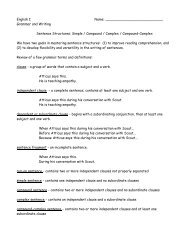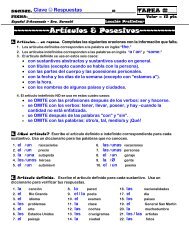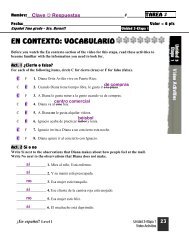Ode on a Grecian Urn.pdf
Ode on a Grecian Urn.pdf
Ode on a Grecian Urn.pdf
Create successful ePaper yourself
Turn your PDF publications into a flip-book with our unique Google optimized e-Paper software.
<str<strong>on</strong>g>Ode</str<strong>on</strong>g> <strong>on</strong> a <strong>Grecian</strong> <strong>Urn</strong><br />
by John Keats<br />
Presented by Alisa Granada, Pamela Weidman, Sevan<br />
Dulgarian
Background Informati<strong>on</strong><br />
●<br />
●<br />
●<br />
John Keats (1795-1821): English poet;<br />
poems not popular during life, but<br />
recognized now as <strong>on</strong>e of the greatest<br />
Romanticism poets<br />
<str<strong>on</strong>g>Ode</str<strong>on</strong>g> <strong>on</strong> a <strong>Grecian</strong> <strong>Urn</strong> is <strong>on</strong>e of his<br />
Great <str<strong>on</strong>g>Ode</str<strong>on</strong>g>s of 1819 (<str<strong>on</strong>g>Ode</str<strong>on</strong>g> to a<br />
Nightingale, <str<strong>on</strong>g>Ode</str<strong>on</strong>g> <strong>on</strong> Melancholy, <str<strong>on</strong>g>Ode</str<strong>on</strong>g><br />
<strong>on</strong> Indolence, <str<strong>on</strong>g>Ode</str<strong>on</strong>g> to Psyche)<br />
This poem is an example of ekphrasis<br />
(<strong>on</strong>e form of art is used to describe<br />
another)
General Poetic Devices<br />
● Themes and symbolism of urn: art, truth, beauty,<br />
reality, emoti<strong>on</strong>s<br />
● Rhyme scheme: not strict rhyming (ABAB, then<br />
usually CDE CDE). Divides each stanza into two<br />
porti<strong>on</strong>s: 1) describing/analyzing appearance of<br />
urn 2) exploring significance/mystery/c<strong>on</strong>necti<strong>on</strong><br />
to real life<br />
● Form: five stanzas, rhythmic indentati<strong>on</strong>s<br />
● Word choice: (virgin imagery in first few stanzas,<br />
repetiti<strong>on</strong> of "happy" in stanza three, "Cold<br />
Pastoral", etc.)
Essential Questi<strong>on</strong>s<br />
●<br />
●<br />
●<br />
●<br />
●<br />
One interpretati<strong>on</strong> of this poem is that the urn symbolizes art and art’s<br />
purpose: if this is right, what do you think Keats think art’s<br />
purpose/meaning/importance is Do you agree with this interpretati<strong>on</strong><br />
List the things that the urn symbolizes (beauty, truth, idealistic world, art,<br />
etc.). Any c<strong>on</strong>necti<strong>on</strong>s between the different possible meanings<br />
How does the speaker’s view towards the urn change in each verse<br />
How do the last two lines of the poem change the rest of the poem’s<br />
meaning There’s some dispute over whether these lines add or detract<br />
from the poem--thoughts<br />
How does this poem c<strong>on</strong>nect to the characteristics of Romanticism Does<br />
this shed light <strong>on</strong> attitude of speaker/poem’s message
First Stanza<br />
Thou still unravish'd bride of quietness,<br />
Thou foster-child of silence and slow time<br />
Sylvan historian, who canst thus express<br />
A flowery tale more sweetly than our rhyme:<br />
What leaf-fring'd legend haunts about thy shape<br />
Of deities or mortals, or of both,<br />
In Tempe or the dales of Arcady<br />
What men or gods are these What maidens loth<br />
What mad pursuit What struggle to escape<br />
What pipes and timbrels What wild ecstasy
First Stanza<br />
-Emphasizes ancientness/mystery of urn ("...<br />
quietness / Thou foster-child of silence and<br />
slow time")<br />
-Emphasizes legends/supernatural found in<br />
myths ("Of deities or mortals, or of both")<br />
-Repeated questi<strong>on</strong>s (lines 8-10): set up<br />
following stanzas, emphasize how urn is<br />
mysterious/can't be fully defined or<br />
understood<br />
-Pers<strong>on</strong>ifies urn: "Thou," "foster child," "Sylvan<br />
historian"
Sec<strong>on</strong>d Stanza<br />
Heard melodies are sweet, but those unheard<br />
Are sweeter; therefore, ye soft pipes, play <strong>on</strong>;<br />
Not to the sensual ear, but, more endear'd,<br />
Pipe to the spirit ditties of no t<strong>on</strong>e:<br />
Fair youth, beneath the trees, thou canst not leave<br />
Thy s<strong>on</strong>g, nor ever can those trees be bare;<br />
Bold Lover, never, never canst thou kiss,<br />
Though winning near the goal yet, do not grieve;<br />
She cannot fade, though thou hast not thy bliss<br />
For ever wilt thou love, and she be fair!
Sec<strong>on</strong>d Stanza<br />
-<strong>Urn</strong> is in state of innocence/unknown: parallels to<br />
lovers, the experience of c<strong>on</strong>necting to the art, and<br />
the "unravish'd bride"/"pipes" virginal image system.<br />
-Poem's speaker is like the Lover depicted <strong>on</strong> the urn<br />
and the "mad pursuit" in first stanza: both the urn and<br />
the female <strong>on</strong> the urn are pure and unattainable.<br />
Lover and speaker want to "attain"<br />
-<strong>Urn</strong>'s emoti<strong>on</strong>s are pure and perhaps not real: "She<br />
cannot fade, though thou hast not thy bliss"
Third Stanza<br />
Ah, happy, happy bough! that cannot shed<br />
Your leaves, nor ever bid the Spring adieu;<br />
And, happy melodist, unwearied,<br />
For ever piping s<strong>on</strong>gs for ever new;<br />
More happy love! more happy, happy love!<br />
For ever warm and still to be enjoy'd,<br />
For ever panting, and for ever young;<br />
All breathing human passi<strong>on</strong> far above,<br />
That leaves a heart high-sorrowful and cloy'd,<br />
A burning forehead, and a parching t<strong>on</strong>gue
Third Stanza<br />
-Dramatic shift in mood: extremely joyous. "happy"<br />
repeated six times; subject of the stanza is a Spring<br />
scene of the passi<strong>on</strong> <strong>on</strong> the urn. C<strong>on</strong>trasts to passi<strong>on</strong><br />
experienced in real life.<br />
-"All breathing human passi<strong>on</strong> far above, / That<br />
leaves a heart high-sorrowful and cloy'd, / A burning<br />
forehead, and a parching t<strong>on</strong>gue": compares urn's<br />
perfect happiness to the "burning" pain of real<br />
passi<strong>on</strong>.<br />
-What is the purpose of this comparis<strong>on</strong> What is<br />
the speaker's opini<strong>on</strong> towards emoti<strong>on</strong>s in the urn and<br />
emoti<strong>on</strong>s in real life
Fourth Stanza<br />
Who are these coming to the sacrifice<br />
To what green altar, O mysterious priest,<br />
Lead'st thou that heifer lowing at the skies,<br />
And all her silken flanks with garlands drest<br />
What little town by river or sea shore,<br />
Or mountain-built with peaceful citadel,<br />
Is emptied of this folk, this pious morn<br />
And, little town, thy streets for evermore<br />
Will silent be; and not a soul to tell<br />
Why thou art desolate, can e'er return.
Fourth Stanza<br />
-The <strong>on</strong>ly images actually <strong>on</strong> the urn are the people<br />
leading the heifer to the altar. Everything else is created<br />
by the speaker's imaginati<strong>on</strong><br />
-Like first stanza, speaker uses a series of questi<strong>on</strong>s: "Who<br />
are these coming to the sacrifice / ...And all her silken<br />
flanks with garlands drest"<br />
-Romantic characteristic: the "world" of the urn is<br />
expanded to include a "little town" "mountain-built with<br />
peaceful citadel" by speaker's imaginati<strong>on</strong>. The speaker's<br />
own individual, subjective experience creates what lies<br />
bey<strong>on</strong>d the image. What does this say about the effect a<br />
viewer has when experiencing art
Fifth Stanza<br />
O Attic shape! Fair attitude! with brede<br />
Of marble men and maidens overwrought,<br />
With forest branches and the trodden weed;<br />
Thou, silent form, dost tease us out of thought<br />
As doth eternity: Cold Pastoral!<br />
When old age shall this generati<strong>on</strong> waste,<br />
Thou shalt remain, in midst of other woe<br />
Than ours, a friend to man, to whom thou say'st,<br />
"Beauty is truth, truth beauty,--that is all<br />
Ye know <strong>on</strong> earth, and all ye need to know."
Fifth Stanza<br />
-Brings image systems together: "marble" "maidens" "forest<br />
branches."<br />
-Pers<strong>on</strong>ifies the urn, like in the first stanza, but the t<strong>on</strong>e<br />
seems a little more frustrated. "silent form"..."Cold<br />
Pastoral!" emphasizes that the urn is not real and "teases<br />
us out of thought" because it is not fully understandable<br />
("Cold" c<strong>on</strong>trasts to "burning" real-life passi<strong>on</strong>s in third<br />
stanza)<br />
-<strong>Urn</strong> will "remain," c<strong>on</strong>taining truth and beauty, even<br />
when their generati<strong>on</strong> is g<strong>on</strong>e. "A friend to man" that will<br />
still exist. Although speaker laments that he can't fully<br />
understand the urn, he recognizes its importance and<br />
eternal beauty
Essential Questi<strong>on</strong>s<br />
●<br />
●<br />
●<br />
●<br />
●<br />
One interpretati<strong>on</strong> of this poem is that the urn symbolizes art and art’s<br />
purpose: if this is right, what do you think Keats think art’s<br />
purpose/meaning/importance is Do you agree with this interpretati<strong>on</strong><br />
List the things that the urn symbolizes (beauty, truth, idealistic world, art,<br />
etc.). Any c<strong>on</strong>necti<strong>on</strong>s between the different possible meanings<br />
How does the speaker’s view towards the urn change in each verse<br />
How do the last two lines of the poem change the rest of the poem’s<br />
meaning There’s some dispute over whether these lines add or detract<br />
from the poem--thoughts<br />
How does this poem c<strong>on</strong>nect to the characteristics of Romanticism Does<br />
this shed light <strong>on</strong> attitude of speaker/poem’s message
Art C<strong>on</strong>necti<strong>on</strong><br />
This is an image of a st<strong>on</strong>e<br />
relief depicting Greek actors<br />
telling a traditi<strong>on</strong>al story.<br />
● In the poem: the reader<br />
interprets the speaker<br />
interpreting the images <strong>on</strong><br />
the urn<br />
● In the image: the audience<br />
interprets the actors<br />
interpreting the script<br />
● How does this c<strong>on</strong>nect to<br />
themes about truth and<br />
art Can art ever directly<br />
c<strong>on</strong>vey the truth or<br />
message


